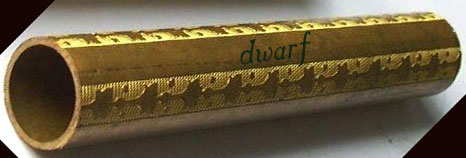Runebound Warrior Invasion
It began with the discovery of the DWARF tube…
After the treachery of the orcs in 899TA, U-Gene's warriors adopted a practice of raiding rebel camps on a regular basis. During mid-winter at one such camp, in the village of Drodden deep in the plains of Wintershriven, a simple brass tube was discovered. The tube had the word "dwarf" written on it and was empty. After an examination by the mages in the employ of the Dwarf King, it was set aside.
When a young dwarf fancied melting it down, he discovered a note had mysteriously appeared inside the tube: a secret code. The code made its way through the brightest dwarven scholars, and landed on U-Gene's desk unsolved.
With the dwarves unable to crack the code, Hylax was brought in to study its cryptic message. A few minutes later, the wizened gnome looked up, a smile on his lips. "The Tomb is Awoken. The South rises against the Oppressors. The Northern Fleet is a Decoy. The Castles of the Winds will be Our Secret Weapon. The Orcs are Uncertain."
With attacks from the south immanent, U-Gene ordered the mobilization of all troops in the Reaches in late March 900. This order included the Orcs who had suffered greatly from their treachery in the campaign season of 899. Troops were stationed along the western coast, awaiting another Tang invasion while the Southern Reaches were garrisoned against the arrival of armies from both the Tomb Kingdom and Sandal. The Second War of the Reaches moved into its second campaign season.
The mystery of the Castles of the Winds was quickly solved as reports started coming in from Guildford of a strange castle appearing in the hills south of Bishopshill in the Shadowyarn Mountains. It was reported that an army of ratmen were pouring from the castle into the surrounding hills and forests. U-Gene summoned his compatriots and set off for the castle.
While two Castles of the Winds were stopped by the party - the one in Bishopshill and one near Teufeldorf, two others were allowed to disgourge their charges - rat soldiers and the impossibly tough Runebound Warriors. One of these castles appeared just west of Dragonsford. The other was just south of the Whispering Hills. And so the battle began.
In March, the Tang army near Dragonsford crossed the River White and headed north, attempting to sack the newly-constructed Grey Wolf Keep. After an unsuccessful siege, the knights of Dragonsford caught up with the invaders later in March near the keep and, in a bloody open field exchange, wiped the Tang ratmen out.
Meanwhile, the Sandalese knights marched north and immediately began their siege of Crossgate Keep while the Tang from the south attacked nearby Lechlade Keep. Crossgate fell immediately while Lechlade kept their defenses up for two months - eventually falling in May 900.
Using cunning generalship, the Elven Admirals determined that their small but agile navy could move around the Tang Armada and strike at the back of the Sandalese warships. These ships were filled with Sandalese knights and heavy foot soldiers destined for an attack on Teufeldorf. With support from both the Eagles and the Dwarven copters, the surprise attack went off like clockwork - sinking the entire Sandalese navy without any loss of life for the elves.
A later retaliation by the Tang was to sink the Elven navy - although with no significant impact to the overall campaign.
Meanwhile, the dwarven army bypassed the fighting in the Southern Reaches and headed into Sandal itself to wreak some vengeance. Whitehall Castle fell in July, the Castle of Mirror fell in August, the Sandalese capital of Durcheinander fell in September and the Tanglewood Castle fell in October. With no resistance from the sparse locals left in Sandal, the route of four major military points within the country marked a significant dwarven victory.
As the invaders concentrated on attacking Teufeldorf, the knights of the Realm decided on a tactic of delays - engaging the enemy in losing battles that would slow their progress towards the capital. The gnomish commander Quintus - whose brilliant attacks of 899 were already becoming legendary - was put in command of the human castles and troops on the battlefield. The bravery of the gnomes, as they fought overwhelming odds, will be a story told around campfires for years to come.
In August, Grunfeld Castle went under siege - falling to the Tang in September. Asgard Castle, newly built, also fell in October 900. However, the tactics of the gnomes caused the northern march of the Tang soldiers to falter and slow.
The final large open field battle took place just south of Teufeldorf. The forces of the Tang Empire outside the human capital, facing an eventual pincer movement from the knights from the south and garrison inside Teufeldorf - and now with no hope of their own from the delayed southern Tang army - attacked the knights in August 900 in the Battle of Vardan. The humans carried the day with the vast majority of the ratmen slaughtered.
Breaking the siege and with the southern Tang army stalled, Teufeldorf would be safe for another year.
